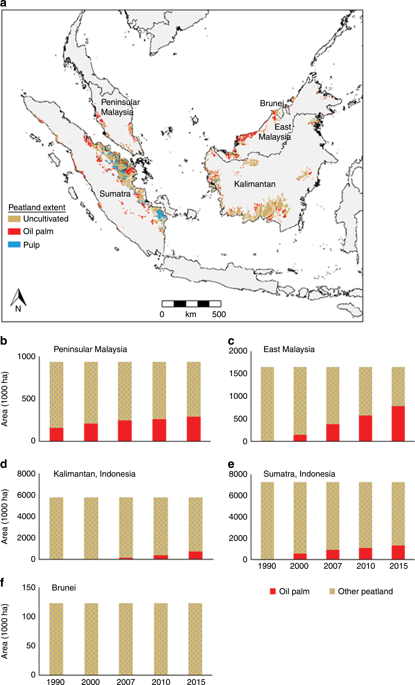当前位置:
X-MOL 学术
›
Nat. Commun.
›
论文详情
Our official English website, www.x-mol.net, welcomes your
feedback! (Note: you will need to create a separate account there.)
Greenhouse gas emissions resulting from conversion of peat swamp forest to oil palm plantation.
Nature Communications ( IF 14.7 ) Pub Date : 2020-01-21 , DOI: 10.1038/s41467-020-14298-w Hannah V Cooper 1 , Stephanie Evers 2, 3 , Paul Aplin 4 , Neil Crout 1 , Mohd Puat Bin Dahalan 5 , Sofie Sjogersten 1, 4
Nature Communications ( IF 14.7 ) Pub Date : 2020-01-21 , DOI: 10.1038/s41467-020-14298-w Hannah V Cooper 1 , Stephanie Evers 2, 3 , Paul Aplin 4 , Neil Crout 1 , Mohd Puat Bin Dahalan 5 , Sofie Sjogersten 1, 4
Affiliation

|
Conversion of tropical peat swamp forest to drainage-based agriculture alters greenhouse gas (GHG) production, but the magnitude of these changes remains highly uncertain. Current emissions factors for oil palm grown on drained peat do not account for temporal variation over the plantation cycle and only consider CO2 emissions. Here, we present direct measurements of GHGs emitted during the conversion from peat swamp forest to oil palm plantation, accounting for CH4 and N2O as well as CO2. Our results demonstrate that emissions factors for converted peat swamp forest is in the range 70-117 t CO2 eq ha-1 yr-1 (95% confidence interval, CI), with CO2 and N2O responsible for ca. 60 and ca. 40% of this value, respectively. These GHG emissions suggest that conversion of Southeast Asian peat swamp forest is contributing between 16.6 and 27.9% (95% CI) of combined total national GHG emissions from Malaysia and Indonesia or 0.44 and 0.74% (95% CI) of annual global emissions.
中文翻译:

泥炭沼泽森林转化为油棕种植园导致的温室气体排放。
热带泥炭沼泽森林向排水农业的转化改变了温室气体的产生,但这些变化的幅度仍然非常不确定。在排水泥炭上生长的油棕的当前排放因子无法解决人工林周期内的时间变化,仅考虑CO2排放。在这里,我们介绍了从泥炭沼泽森林到油棕种植的转化过程中排放的温室气体的直接测量值,其中包括CH4和N2O以及CO2。我们的结果表明,转化后的泥炭沼泽森林的排放因子在70-117 t CO2当量ha-1 yr-1(95%置信区间,CI)范围内,其中CO2和N2O造成的排放因子约为70。60和ca. 此值分别为40%。这些温室气体排放表明,东南亚泥炭沼泽森林的转化贡献了16.6至27。
更新日期:2020-01-22
中文翻译:

泥炭沼泽森林转化为油棕种植园导致的温室气体排放。
热带泥炭沼泽森林向排水农业的转化改变了温室气体的产生,但这些变化的幅度仍然非常不确定。在排水泥炭上生长的油棕的当前排放因子无法解决人工林周期内的时间变化,仅考虑CO2排放。在这里,我们介绍了从泥炭沼泽森林到油棕种植的转化过程中排放的温室气体的直接测量值,其中包括CH4和N2O以及CO2。我们的结果表明,转化后的泥炭沼泽森林的排放因子在70-117 t CO2当量ha-1 yr-1(95%置信区间,CI)范围内,其中CO2和N2O造成的排放因子约为70。60和ca. 此值分别为40%。这些温室气体排放表明,东南亚泥炭沼泽森林的转化贡献了16.6至27。











































 京公网安备 11010802027423号
京公网安备 11010802027423号